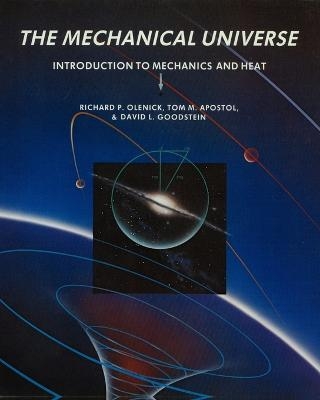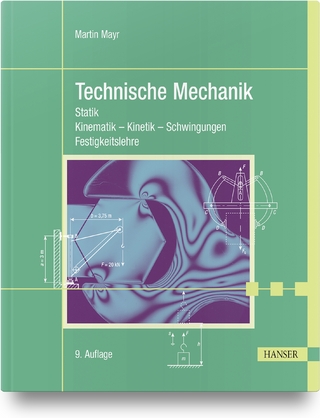
The Mechanical Universe
Cambridge University Press (Verlag)
978-0-521-71592-8 (ISBN)
This important textbook is based on, though independent of, an educational TV series The Mechanical Universe broadcast on public television in the United States. Its aim is to guide students and general readers to an understanding of how the physical world works; physics is presented as a human endeavour, with historical development forming a thread throughout the text. The prerequisites are minimal, only basic algebra and trigonometry since the necessary calculus is developed in the text, with physics providing the motivation. New concepts are introduced at the natural, logical point with many historical references to place physics in a social perspective. Many topics from twentieth-century physics are included, for example energy, low temperature physics, relativity and black holes. The book is attractively and profusely illustrated and will be welcomed by students and also by general readers for whom this will be a stimulating alternative to other, less-thorough treatments.
Richard P. Olenick is currently the chair of Department of Physics at University of Dallas. He was Associate Project Director of the PBS Series The Mechanical Universe and Beyond the Mechanical Universe, which accompanied this textbook and its successors. He has received numerous grants from the National Science Foundation and the US Department of Education for his work in physics education. His current project is C3P, which developed an inquiry-based curriculum for high school physics. In 1995, Dr Olenick was named Texas Professor of the Year by the Carnegie Foundation and in 1997, he was named a Minnie Piper Steven Professor. In 2003, he became the Nancy Cain Marcus and Jeffrey A. Marcus Chair in Science and in 2005 he received the King Award from the University of Dallas, which is the highest honor the University can bestow on a faculty member. Tom M. Apostol joined the California Institute of Technology faculty in 1950 and is now Professor of Mathematics, Emeritus. He is internationally known for his textbooks on Calculus, Analysis, and Analytic Number Theory, which have been translated into 5 languages, and for creating Project MATHEMATICS!, a series of video programs that bring mathematics to life with computer animation, live action, music, and special effects. The videos have won first-place honors at a dozen international video festivals, and have been translated into Hebrew, Portuguese, French, and Spanish. His list of publications includes 98 research papers, 46 of them published since he retired in 1992. He has received several awards for his research and teaching. In 1978 he was a visiting professor at the University of Patras in Greece, and in 2000 was elected a Corresponding Member of the Academy of Athens, where he delivered his inaugural lecture in Greek. Dr David L. Goodstein is Vice Provost and Professor of Physics and Applied Physics at the California Institute of Technology, where he has been on the faculty for over 35 years. In 1995, he was named the Frank J. Gilloon Distinguished Teaching and Service Professor. In 1999, Dr Goodstein was awarded the Oersted Medal of the American Association of Physics Teachers, and in 2000, the John P. McGovern Medal of the Sigma Xi Society. He has served on and chaired numerous scientific and academic panels, including the National Advisory Committee to the Mathematical and Physical Sciences Directorate of the National Science Foundation. He is a founding member of the Board of Directors of the California Council on Science and Technology. His books include States of Matter and Feynman's Lost Lecture, written with his wife, Dr Judith Goodstein. In the 1980's, he was Director and host of The Mechanical Universe television program which has been viewed by millions.
Preface; 1. Introduction to the mechanical universe; 2. The law of falling bodies; 3. Derivatives; 4. Inertia; 5. Vectors; 6. Newton's law; 7. Integration; 8. The apple and the moon; 9. Moving in circles; 10. Forces; 11. Gravity, electricity, and magnetism; 12. The Milliken oil-drop experiment; 13. The law of conservation of energy; 14. Energy and stability; 15. Temperature and the gas laws; 16. The engine of nature; 17. Entropy; 18. The quest for low temperatures; 19. The conservation of momentum; 20. Harmonic motion; 21. Resonance; 22. Coupled oscillators and waves; 23. Angular momentum; 24. Gyroscopes; 25. Kepler's laws and the conic sections; 26. Solving the Kepler problem; 27. Energy and eccentricity; 28. Navigating in space; 29. Loose ends and black holes; 30. The harmony of the spheres: an overview of the mechanical universe; Appendix A. The international system of units; Appendix B. Conversion factors; Appendix C. Formulas from algebra, geometry, and trigonometry; Appendix D. Astronomical data; Appendix E. Physical constants; Selected bibliography; Index.
| Erscheint lt. Verlag | 14.1.2008 |
|---|---|
| Zusatzinfo | Worked examples or Exercises; 20 Tables, unspecified; 45 Halftones, unspecified; 370 Line drawings, unspecified |
| Verlagsort | Cambridge |
| Sprache | englisch |
| Maße | 205 x 235 mm |
| Gewicht | 1920 g |
| Themenwelt | Naturwissenschaften ► Physik / Astronomie ► Mechanik |
| ISBN-10 | 0-521-71592-X / 052171592X |
| ISBN-13 | 978-0-521-71592-8 / 9780521715928 |
| Zustand | Neuware |
| Haben Sie eine Frage zum Produkt? |
aus dem Bereich


